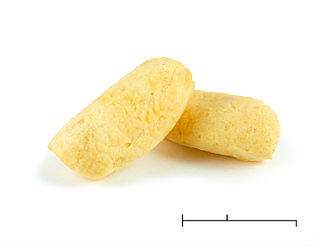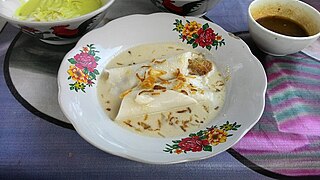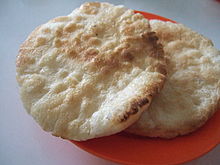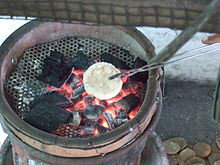
Indonesian cuisine is a collection of various regional culinary traditions that formed the archipelagic nation of Indonesia. There are a wide variety of recipes and cuisines in part because Indonesia is composed of approximately 6,000 populated islands of the total 17,508 in the world's largest archipelago, with more than 1,300 ethnic groups. Many regional cuisines exist, often based upon indigenous culture with some foreign influences. Indonesia has around 5,350 traditional recipes, with 30 of them considered the most important. Indonesia's cuisine may include rice, noodle and soup dishes in modest local eateries to street-side snacks and top-dollar plates.

Malay cuisine is the traditional food of the ethnic Malays of Southeast Asia, residing in modern-day Malaysia, Indonesia, Singapore, Brunei, Southern Thailand and the Philippines as well as Cocos Islands, Christmas Island, Sri Lanka and South Africa.

South Sumatra is a province of Indonesia, located on the southeast of the island of Sumatra, The province is 91,592.43 km2 (35,364 sq mi) and has a population of 8,467,432 at the 2020 Census. The capital of the province is Palembang. The province borders the provinces of Jambi to the north, Bengkulu to the west and Lampung to the south. The Bangka Strait in the east separates South Sumatra and the island of Bangka, which is part of the Bangka Belitung Islands province. The province is rich in natural resources, such as petroleum, natural gas and coal. The province is inhabited by many different ethnic groups, with Palembangese being largest ethnic group. Most speak hhe Palembang language, which is mutually intelligible to both Indonesian and local Malay. Other ethnic groups include the Javanese, Sundanese, Minangkabau and Chinese. Most are concentrated in urban areas and are largely immigrants from other parts of Indonesia.

Otak-otak is a Southeast Asian fish cake made of ground fish mixed with spices and wrapped in leaf parcels. Otak-otak is traditionally served steamed or grilled, encased within the leaf parcel it is cooked in, and can be eaten solely as a snack or with steamed rice as part of a meal.

Tempoyak, asam durian or pekasam is a Malay condiment made from fermented durian. It is usually consumed by the ethnic Malays in Maritime Southeast Asia, notably in Indonesia and Malaysia. Tempoyak is made by taking the flesh of durian and mixing it with some salt and kept in room temperature for three or five days for fermentation. Tempoyaks are usually made during the durian season, when the abundance of durian and excess production are made into fermented tempoyak.

Pempek, mpek-mpek or empek-empek is a savoury Indonesian fishcake delicacy, made of fish and tapioca, from Palembang, South Sumatera, Indonesia. Pempek is served with rich sweet and sour sauce called kuah cuka or kuah cuko, or just "cuko". Sometimes local people also eat the dish with yellow noodles and diced up cucumber to balance out the vinegar's sourness.

Padang food or Minang food is the cuisine of the Minangkabau people of West Sumatra, Indonesia. It is among the most popular cuisines in Maritime Southeast Asia. It is known across Indonesia as Masakan Padang after Padang, the capital city of Western Sumatra province. It is served in restaurants mostly owned by perantauan (migrating) Minangkabau people in Indonesian cities. Padang food is ubiquitous in Indonesian cities and is popular in neighboring Malaysia and Singapore.

Amplang, also known as kerupuk kuku macan, is an Indonesian traditional savoury fish cracker snack commonly found in Indonesia and Malaysia. Amplang crackers are commonly made of ikan tenggiri (wahoo) or any type of Spanish mackerel, mixed with starch and other materials, and then fried.

Nasi padang, sometimes referred to as Padang rice, is a Minangkabau dish of steamed rice served with various choices of pre-cooked dishes originating from West Sumatra, Indonesia. It is named after the city of Padang, capital of the West Sumatra province. A miniature banquet of meats, fish, vegetables, and spicy sambals eaten with plain white rice, it is Sumatra's most famous export and the Minangkabau people's primary contribution to Indonesian cuisine.

Krupuk kulit is a traditional Indonesian cattle skin krupuk (cracker). Traditionally it is made from the soft inner skin of cattle, diced, and sun-dried until it hardens and loses most of its water content. The diced and dried skin are later fried in ample hot cooking oil until they expand in similar fashion with bubble and yield a crispy texture. This fried cattle skin is then sealed in vacuum plastic bags to ensure and prolong its crispiness.

Sambal is an Indonesian chilli sauce or paste, typically made from a mixture of a variety of chilli peppers with secondary ingredients, such as shrimp paste, garlic, ginger, shallot, scallion, palm sugar, and lime juice. Sambal is an Indonesian loan-word of Javanese origin. It originated from the culinary traditions of Indonesia, and is also an integral part of the cuisines of Singapore, Malaysia, Brunei, and Sri Lanka. It has also spread through overseas Indonesian populations to the Netherlands and Suriname.

Kripik or keripik are Indonesian chips or crisps, bite-size snack crackers that can be savoury or sweet. They are made from various dried fruits, tubers, vegetables, and fish that have undergone a deep frying process in hot vegetable oil. They can be lightly seasoned with salt, or spiced with chili powder and sugar.

Krupuk (Javanese), kurupuk (Sundanese), kerupuk (Indonesian), keropok (Malay), kroepoek (Dutch) or kropek (Tagalog) is a cracker made from starch or animal skin and other ingredients that serve as flavouring. Most krupuk are deep fried, while some others are grilled or hot sand fried. They are a popular snack in maritime Southeast Asia, and is most closely associated with the culinary traditions of Indonesia, in particular Javanese cuisine. It is an ubiquitous staple in its country of origin, and has spread to other countries either via the migration of diaspora populations or exports.

Fish crackers are deep fried crackers made from fish and spices, originating from Indonesia. The crackers are made mainly with tapioca flour and/or sago flour and then salt, sugar and MSG as seasonings. Fish crackers can be found throughout Southeast Asia and East Asia. However, they are more commonly found and of greater variety in Indonesia and Malaysia.

Prawn crackers are a deep fried snack made from starch and prawn. They are a common snack food in Southeast Asian cuisine, but they are most closely associated with Indonesia. They have also been adapted into East Asian cuisines, where the similar Japanese kappa ebisen (かっぱえびせん) (Japan) and Korean saeukkang (Korea) are popular snacks.

Pindang refers to a cooking method in the Indonesian and Malay language of boiling ingredients in brine or acidic solutions. Usually employed to cook fish or egg, the technique is native to Sumatra especially in Palembang, but has spread to Java and Kalimantan. The term also could refer to a specific sour and spicy fish soup which employs seasonings like tamarind. Pindang has food preservation properties, which extends the shelf life of fish products.

Palembangese cuisine is the cuisine of the Palembangese people of the city of Palembang in the South Sumatra province of Indonesia. It is the second most well-known cuisine from Sumatra after Padang.

Burgo is an Indonesian folded rice pancake served in savoury whitish coconut milk-based soup, flavoured with fish, and sprinkled with fried shallots. The dish is one of the regional specialty of Palembang, the capital of South Sumatra, Indonesia. In Palembang, burgo is a popular choice for breakfast. Burgo is quite similar with lakso, although lakso is thick rice noodles and its soup has yellowish color acquired from turmeric.

Indonesian noodles are a significant aspect of Indonesian cuisine which is itself very diverse. Indonesian cuisine recognizes many types of noodles, with each region of the country often developing its own distinct recipes.




















